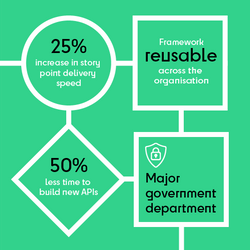How to buy from a trusted supplier on the Digital Specialists and Programmes framework
Buying digital services through CCS frameworks can seem nebulous. Our step-by-step guide on buying from from us on the DSP programme makes it easy.
Read more
At the end of the Brexit transition period in January 2021, HMRC was facing a new reality. Frictionless trade with the EU — with its built-in security controls and regulations on goods flowing between its countries — was on the way out. Questions abounded about how future trade with the bloc would pan out: logistics-wise, relations-wise, and most importantly in terms of securing the UK against the risk posed by unchecked goods.
Two years later, trade is still flowing frictionlessly, safely, and securely — in no small part thanks to Tecknuovo’s work with HMRC to build a greenfield logistics system to manage checks on incoming goods.
This system ensures the highest levels of national security in the ports by protecting the UK from unregulated materials and goods that could create lasting negative impact to the economy, public health and more.
In this article, I reflect on how that system has helped, and continues to help, HMRC create a vital safety net to protect the nation against the security risks that could have been.
HMRC needed a greenfield system to:
It would be called the Goods Vehicle Movement System (GVMS), and Tecknuovo would play a critical part in building it, rolling it out, and maintaining it in conjunction with the UK Border Force to guard the country against threats to national security through imports.
Carrying this heavy weight of national security, the solution naturally needed to be resilient, sustainable, and secure. But that wasn’t the only challenge — our teams were up against an immovable deadline for the system to go live in time for the UK’s full transition out of the single market. On top of that, Brexit negotiations were ongoing and changing daily. Finally, the cherry on top of the cake: this all played out during the highest peak of the national Covid-19 national lockdown.
Despite this perfect storm of challenges, Tecknuovo’s teams delivered at record pace ahead of the 1st January deadline.
Working in a complex environment with other suppliers and HMRC’s stakeholders, we quickly agreed the project’s requirements. And no more than a day after the SoW was signed, we had mobilised a team of 40+ specialist engineers to start the work.
The core tenets of our work revolved around:
It was imperative for the system to process the high volumes of complex data that would securely pass through it incessantly. Our engineers built a resilient system that can receive input messages, create, populate, and update the Goods Movement Reference, as well as send on responses and alerts. The system can read and validate data from HMRC’s other inbuilt systems, as well as notify these systems when goods embark or arrive through the GVMS.
To deliver at top speed and quality, we introduced a plan to implement best-in-class agile methodology and delivery at HMRC. Working through a collaborative one-team approach, we embedded stand-ups, burndowns, retrospectives, mob programming and live specs. This didn’t just accelerate and improve the quality of delivery — it also melded a close working relationship between Tecknuovo, HMRC, and the raft of other suppliers involved in the multi-faceted project.
Carrying responsibility for national security, HMRC wanted to give the GVMS programme additional security guardrails post go-live. To meet the demand, we rapidly security cleared and onboarded a dedicated Hypercare team to monitor and keep the system running smoothly 24/7 over the go-live period. Our team’s vigilant work meant that incident levels remained negligible throughout the go-live phase.
In fact, the system was so secure and well-performing that we could ramp down the 24/7 Hypercare support a whole six weeks earlier than planned.
Why is GVMS so important, and what would happen without it?
If imports didn’t halt, but went ahead unchecked, the UK would be faced with palpable risks of nationwide breakouts of disease from dangerous products, or harmful materials.
The more realistic answer is that the large volume of good currently being imported from the EU would have to halt completely. This would spell catastrophe for the economy by leading to shortages in medication, raw materials such as steel and iron, foodstuffs, transport equipment and more — in turn leading to collapsing industries, healthcare, and quality of life for citizens.
In light of this, HMRC’s GVMS is a prime example of how government can leverage technology to deliver enhanced critical national infrastructure services and implement security measures on a national level.
Tecknuovo played a critical part in our journey to continuing seamless trade with the EU after the Brexit transition date. They delivered a purpose-built system for adapting to evolving requirements during development and after, and the teams’ flexibility and speed to adjust were instrumental for ensuring a smooth go-live period.

Buying digital services through CCS frameworks can seem nebulous. Our step-by-step guide on buying from from us on the DSP programme makes it easy.
Read more
The Import Control System (ICS) is a Europe-wide platform needed the build of the greenfield safety and security system to bring together all elements of the goods imports and declarations.
Read more
Rob Kirkham, Tecknuovo IT Manager and cybersecurity aficionado, shares his top three tips for protecting your company in the first post of his cybersecurity series.
Read moreGet the inside scoop — delivered straight to your inbox.